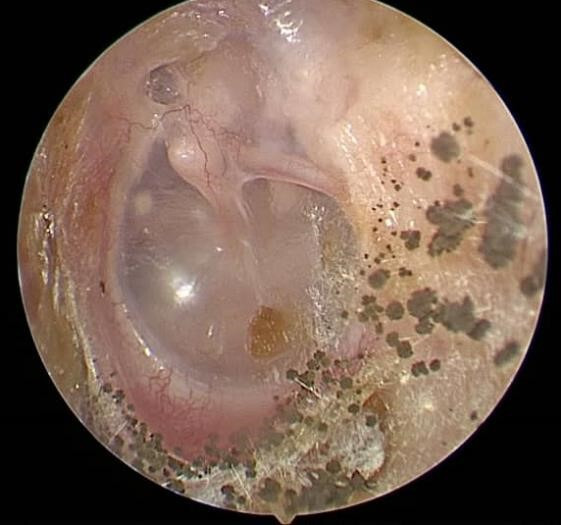Description
A previously healthy 22-year-old man presented with a 1-week history of intermittent left aural pruritus. Besides that, there was no otalgia, otorrhoea, reduced hearing or vertigo. No history of allergy or recent trauma was noted. Rigid nasoendoscopy and facial nerve examination were normal. Otoscopic examination revealed blackish-white spores occupying the left external auditory canal with an intact tympanic membrane (figure 1). Right otoscopic examination was unremarkable. Diagnosis of otomycosis was made based on clinical findings and by swab sent for culture and sensitivity which showed Aspergillus niger. Mechanical debridement was performed under microscopic guidance using suction, and the patient was prescribed antifungal ear drops, which demonstrated resolution of symptoms.
Figure 1.

Blackish-white hyphae occupying left external auditory canal.
Otomycosis, also known as fungal otitis externa, is fungal infections involving the external auditory canal and occasionally middle ear with high prevalence noted among the tropical and humid subtropical regions. Approximately 9% of all otitis externa cases are contributed by otomycosis.1 Overzealous usage of antibiotics has contributed tremendously to the recent surge in the number of otomycosis cases.2 In the same vein, other contributing factors include frequent swimming, immunocompromised conditions such as diabetes mellitus, pregnancy, self-imposed injury of the ear canal by using cotton buds, post canal wall down mastoidectomy, and tympanic membrane perforation.3 The most common identified fungal pathogens include Aspergillus niger and Candida albicans. Otomycosis is diagnosed clinically from history and physical examination. Patients habitually complain of otalgia, pruritus, otorrhoea and even hearing loss. Otoscopic examination typically presents with whitish, cottonlike or blackish greasy spores.
Treatment of otomycosis includes debridement along with antifungal medications. Persistent otomycosis leads to hearing loss, tympanic membrane perforation, fungal otomastoiditis, invasive temporal bone infection and meningoencephalitis.4 It is worth noting that tympanic membrane perforation is one of the overlooked complications of otomycosis. Fungal inoculation of the most medial aspect of the external auditory canal or direct extension of fungal infection into the tympanic membrane leads to mycotic thrombosis of the adjacent blood vessel leading to avascular thrombosis, hence tympanic membrane perforation.5
Learning points.
Otomycosis although common should not be taken lightly as persistent symptoms may have detrimental effects such as hearing loss, tympanic membrane perforation, otomastoiditis and even osteomyelitis.
Regular mechanical debridement under microscopic guidance with topical antifungal drops is deemed necessary.
Otomycosis may be early sign of a more serious and debilitating condition such as diabetes mellitus.
Footnotes
Contributors: JS: writing, editing, literature review. PN: editing, literature review.
Funding: The authors have not declared a specific grant for this research from any funding agency in the public, commercial or not-for-profit sectors.
Competing interests: None declared.
Provenance and peer review: Not commissioned; externally peer reviewed.
Ethics statements
Patient consent for publication
Obtained.
References
- 1.Ho T, Vrabec JT, Yoo D, et al. Otomycosis: clinical features and treatment implications. Otolaryngol Head Neck Surg 2006;135:787–91. 10.1016/j.otohns.2006.07.008 [DOI] [PubMed] [Google Scholar]
- 2.Munguia R, Daniel SJ. Ototopical antifungals and otomycosis: a review. Int J Pediatr Otorhinolaryngol 2008;72:453–9. 10.1016/j.ijporl.2007.12.005 [DOI] [PubMed] [Google Scholar]
- 3.Stren JC, Lucente FE. Otomycosis. Ear Nose Throat J. 1998;67:804–10. [PubMed] [Google Scholar]
- 4.Rutt AL, Sataloff RT. Aspergillus otomycosis in an immunocompromised patient. Ear Nose Throat J 2008;87:622–3. 10.1177/014556130808701107 [DOI] [PubMed] [Google Scholar]
- 5.Hurst WB. Outcome of 22 cases of perforated tympanic membrane caused by otomycosis. J Laryngol Otol 2001;115:879–80. 10.1258/0022215011909486 [DOI] [PubMed] [Google Scholar]


